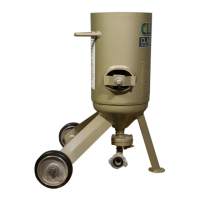MODELS 1028 & 1042 BLAST MACHINES Page 8
© 2013 CLEMCO INDUSTRIES CORP. www.clemcoindustries.com Manual No. 04124, Rev. K
3.7.7 If the nozzle was removed, thoroughly inspect
the nozzle holder threads for wear before installing the
nozzle washer and attaching the nozzle.
3.8 Shutdown
3.8.1 When finished blasting, and after cleanup is
completed, remove the respirator outside the respirator-
use area and where the air is safe to breathe.
3.8.2 Depressurize the blast machine.
3.8.3 Close the compressed-air supply valve at the
compressor.
3.8.4 Drain receiver tank, filters, and water collecting
devices, and bleed the compressed-air supply hose.
3.8.5 Shutdown the compressor.
3.8.6 Cover the machine when not in use. Refer to
Section 7.1 for optional covers.
4.0 PREVENTIVE MAINTENANCE
NOTE: These preventive maintenance instructions
pertain to the blast machine. Read the owners manuals
for all blast accessories, for their inspection and
maintenance schedules.
4.1 Daily Inspection
4.1.1 With the air off, before blasting, inspect the
following:
Make sure that couplings are secure and lock pins
and safety cables are in place.
For machines with manual controls, make sure the
nozzle supporting fixture is secure.
4.1.2 During blasting, inspect the following:
Inspect all couplings and coupling gaskets for leaks.
Check the blast machine for leaks. If leaks are found
around the pop-up valve, inspection door, or pipe
fittings at the bottom of the cone, stop blasting
immediately and repair or replace worn parts.
CAUTION
If leaks are allowed to continue, abrasive
erosion could cause extensive or irreparable
damage to the blast machine.
Check all external piping, control hoses, and valves
for leaks. If leaks are found, stop blasting and repair.
Inspect blast hose, couplings, and nozzle holders for
leaks. At the first sign of a leak, stop blasting and
inspect all items for wear. Replace worn parts.
WARNING
Leaks around couplings and nozzle holders
indicate worn or loose-fitting parts. Nozzle
holders and couplings that do not fit tightly on
hose, and nozzles that do not fit tightly in
nozzle holders could disconnect while under
pressure. Impact from nozzles, couplings,
hoses, or abrasive, and parts disconnected while
under pressure could cause severe injury.
4.2 Weekly Inspection
4.2.1 With the air off, before blasting, inspect the
following:
Inspect the blast hose for wear; squeeze the hose
every three to four feet, look for soft spots. Soft
spots mean the hose is worn. Replace the blast
hose before the tube wears as far as the fabric plies.
WARNING
Worn blast hose could suddenly burst.
Couplings and nozzle holders may not
adequately grip worn hose, causing them to
blow off under pressure. Compressed air and
abrasive escaping from a burst hose, or
disconnected coupling or nozzle holder, could
cause severe injury.
Remove the nozzle for inspection. Replace if the
diameter is worn 1/16 or more, or if the liner is
cracked.
Make sure the nozzle washer is in place and not
worn.
WARNING
The threads on the nozzle and nozzle holder
must be inspected each time the nozzle is
secured to the holder. A loose fitting nozzle
may eject under pressure and could cause
severe injury. Check the threads for wear, and
make sure the nozzle holder securely holds the
nozzle. The nozzle washer must also be
inspected for wear. When nozzle washers are
worn, abrasive could erode nozzle threads.
When an optional air filter is used, inspect the filter
element, and clean the bowl.

